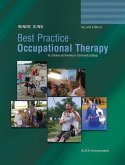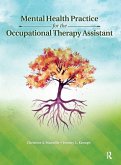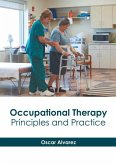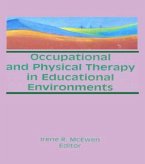Rosemary Hagedorn
Tools for Practice in Occupational Therapy
A Structured Approach to Core Skills and Processes
Schade – dieser Artikel ist leider ausverkauft. Sobald wir wissen, ob und wann der Artikel wieder verfügbar ist, informieren wir Sie an dieser Stelle.
Rosemary Hagedorn
Tools for Practice in Occupational Therapy
A Structured Approach to Core Skills and Processes
- Broschiertes Buch
- Merkliste
- Auf die Merkliste
- Bewerten Bewerten
- Teilen
- Produkt teilen
- Produkterinnerung
- Produkterinnerung
-- A practical guide to the basic skills and processes of occupational therapy. -- Outlines the theory behind occupational therapy while firmly relating it to practice. -- Highly readable and free from jargon, making the text accessible and easy to understand.
Andere Kunden interessierten sich auch für
![Rheumatology Practice in Occupational Therapy Rheumatology Practice in Occupational Therapy]() Rheumatology Practice in Occupational Therapy53,99 €
Rheumatology Practice in Occupational Therapy53,99 €![Handbook of Occupational Therapy Handbook of Occupational Therapy]() Handbook of Occupational Therapy172,99 €
Handbook of Occupational Therapy172,99 €![Best Practice Occupational Therapy for Children and Families in Community Settings Best Practice Occupational Therapy for Children and Families in Community Settings]() Winnie DunnBest Practice Occupational Therapy for Children and Families in Community Settings111,99 €
Winnie DunnBest Practice Occupational Therapy for Children and Families in Community Settings111,99 €![Mental Health Practice for the Occupational Therapy Assistant Mental Health Practice for the Occupational Therapy Assistant]() Christine ManvilleMental Health Practice for the Occupational Therapy Assistant94,99 €
Christine ManvilleMental Health Practice for the Occupational Therapy Assistant94,99 €![Theorising Occupational Therapy Practice in Diverse Settings Theorising Occupational Therapy Practice in Diverse Settings]() Theorising Occupational Therapy Practice in Diverse Settings176,99 €
Theorising Occupational Therapy Practice in Diverse Settings176,99 €![Occupational Therapy: Principles and Practice Occupational Therapy: Principles and Practice]() Occupational Therapy: Principles and Practice160,99 €
Occupational Therapy: Principles and Practice160,99 €![Occupational and Physical Therapy in Educational Environments Occupational and Physical Therapy in Educational Environments]() Irene McewenOccupational and Physical Therapy in Educational Environments154,99 €
Irene McewenOccupational and Physical Therapy in Educational Environments154,99 €-
-
-
-- A practical guide to the basic skills and processes of occupational therapy. -- Outlines the theory behind occupational therapy while firmly relating it to practice. -- Highly readable and free from jargon, making the text accessible and easy to understand.
Produktdetails
- Produktdetails
- Verlag: Elsevier Health Sciences
- Seitenzahl: 336
- Erscheinungstermin: 14. April 2000
- Englisch
- Abmessung: 245mm x 190mm x 25mm
- Gewicht: 654g
- ISBN-13: 9780443061592
- ISBN-10: 0443061599
- Artikelnr.: 20977819
- Herstellerkennzeichnung
- Libri GmbH
- Europaallee 1
- 36244 Bad Hersfeld
- gpsr@libri.de
- Verlag: Elsevier Health Sciences
- Seitenzahl: 336
- Erscheinungstermin: 14. April 2000
- Englisch
- Abmessung: 245mm x 190mm x 25mm
- Gewicht: 654g
- ISBN-13: 9780443061592
- ISBN-10: 0443061599
- Artikelnr.: 20977819
- Herstellerkennzeichnung
- Libri GmbH
- Europaallee 1
- 36244 Bad Hersfeld
- gpsr@libri.de
SECTION 1. INTRODUCTION.Introduction to integrating theory with practice.
Competent occupational performance in the environment (COPE). Understanding
occupation. A taxonomy of human occupation. Levels of occupation.
Environmental levels. Competence. Core processes in occupational therapy.
Why is engagement in occupation therapeutic? Synthesis: the art of
practice.SECTION 2. THERAPEUTIC USE OF SELF.Introduction to therapeutic use
of self. The therapeutic relationship. Dyadic interaction: styles and
skills. Interviewing. Working with groups. Teaching. Professional
education.SECTION 3. ASSESSMENT OF INDIVIDUAL POTENTIAL, ABILITY AND
NEEDS.Introduction to assessment of individual potential, ability and
needs. Assessment at the developmental level. Assessment at the effective
level. Assessment at the organizational level.SECTION 4. OCCUPATIONAL
ANALYSIS AND ADAPTATIONIntroduction to occupational analysis and
adaptation. Approaches to occupational analysis and adaptation.
Microanalysis. Basic task analysis. Basic activity analysis. Macroanalysis
and client-centred analysis. Demand analysis. Applied analysis. Therapeutic
adaptation: approaches and techniques. Functional adaptation.SECTION 5.
ENVIRONMENTAL ANALYSIS AND ADAPTATIONIntroduction to environmental analysis
and adaptation. Analysis of the environment. Therapeutic adaptationand
management of the environment. Analysis and adaptation of the home
environment. Health and safety and accident prevention.REFERENCES GLOSSARY
APPENDIX Assessments: sources of informationINDEX
Competent occupational performance in the environment (COPE). Understanding
occupation. A taxonomy of human occupation. Levels of occupation.
Environmental levels. Competence. Core processes in occupational therapy.
Why is engagement in occupation therapeutic? Synthesis: the art of
practice.SECTION 2. THERAPEUTIC USE OF SELF.Introduction to therapeutic use
of self. The therapeutic relationship. Dyadic interaction: styles and
skills. Interviewing. Working with groups. Teaching. Professional
education.SECTION 3. ASSESSMENT OF INDIVIDUAL POTENTIAL, ABILITY AND
NEEDS.Introduction to assessment of individual potential, ability and
needs. Assessment at the developmental level. Assessment at the effective
level. Assessment at the organizational level.SECTION 4. OCCUPATIONAL
ANALYSIS AND ADAPTATIONIntroduction to occupational analysis and
adaptation. Approaches to occupational analysis and adaptation.
Microanalysis. Basic task analysis. Basic activity analysis. Macroanalysis
and client-centred analysis. Demand analysis. Applied analysis. Therapeutic
adaptation: approaches and techniques. Functional adaptation.SECTION 5.
ENVIRONMENTAL ANALYSIS AND ADAPTATIONIntroduction to environmental analysis
and adaptation. Analysis of the environment. Therapeutic adaptationand
management of the environment. Analysis and adaptation of the home
environment. Health and safety and accident prevention.REFERENCES GLOSSARY
APPENDIX Assessments: sources of informationINDEX
SECTION 1. INTRODUCTION.Introduction to integrating theory with practice.
Competent occupational performance in the environment (COPE). Understanding
occupation. A taxonomy of human occupation. Levels of occupation.
Environmental levels. Competence. Core processes in occupational therapy.
Why is engagement in occupation therapeutic? Synthesis: the art of
practice.SECTION 2. THERAPEUTIC USE OF SELF.Introduction to therapeutic use
of self. The therapeutic relationship. Dyadic interaction: styles and
skills. Interviewing. Working with groups. Teaching. Professional
education.SECTION 3. ASSESSMENT OF INDIVIDUAL POTENTIAL, ABILITY AND
NEEDS.Introduction to assessment of individual potential, ability and
needs. Assessment at the developmental level. Assessment at the effective
level. Assessment at the organizational level.SECTION 4. OCCUPATIONAL
ANALYSIS AND ADAPTATIONIntroduction to occupational analysis and
adaptation. Approaches to occupational analysis and adaptation.
Microanalysis. Basic task analysis. Basic activity analysis. Macroanalysis
and client-centred analysis. Demand analysis. Applied analysis. Therapeutic
adaptation: approaches and techniques. Functional adaptation.SECTION 5.
ENVIRONMENTAL ANALYSIS AND ADAPTATIONIntroduction to environmental analysis
and adaptation. Analysis of the environment. Therapeutic adaptationand
management of the environment. Analysis and adaptation of the home
environment. Health and safety and accident prevention.REFERENCES GLOSSARY
APPENDIX Assessments: sources of informationINDEX
Competent occupational performance in the environment (COPE). Understanding
occupation. A taxonomy of human occupation. Levels of occupation.
Environmental levels. Competence. Core processes in occupational therapy.
Why is engagement in occupation therapeutic? Synthesis: the art of
practice.SECTION 2. THERAPEUTIC USE OF SELF.Introduction to therapeutic use
of self. The therapeutic relationship. Dyadic interaction: styles and
skills. Interviewing. Working with groups. Teaching. Professional
education.SECTION 3. ASSESSMENT OF INDIVIDUAL POTENTIAL, ABILITY AND
NEEDS.Introduction to assessment of individual potential, ability and
needs. Assessment at the developmental level. Assessment at the effective
level. Assessment at the organizational level.SECTION 4. OCCUPATIONAL
ANALYSIS AND ADAPTATIONIntroduction to occupational analysis and
adaptation. Approaches to occupational analysis and adaptation.
Microanalysis. Basic task analysis. Basic activity analysis. Macroanalysis
and client-centred analysis. Demand analysis. Applied analysis. Therapeutic
adaptation: approaches and techniques. Functional adaptation.SECTION 5.
ENVIRONMENTAL ANALYSIS AND ADAPTATIONIntroduction to environmental analysis
and adaptation. Analysis of the environment. Therapeutic adaptationand
management of the environment. Analysis and adaptation of the home
environment. Health and safety and accident prevention.REFERENCES GLOSSARY
APPENDIX Assessments: sources of informationINDEX








